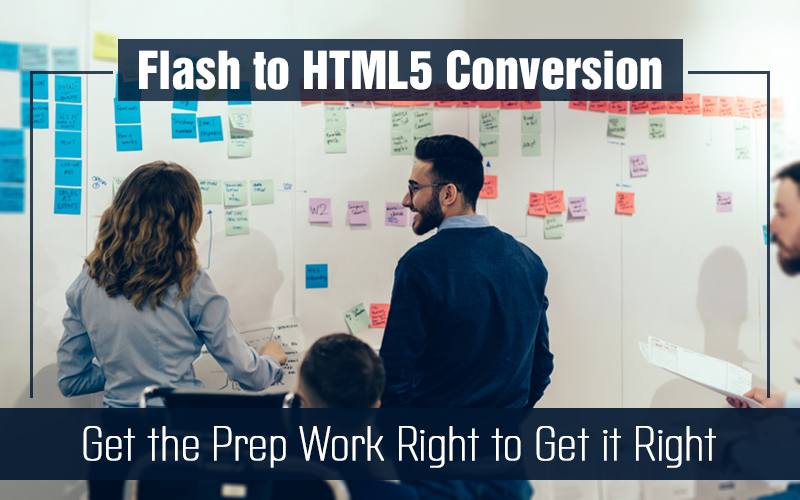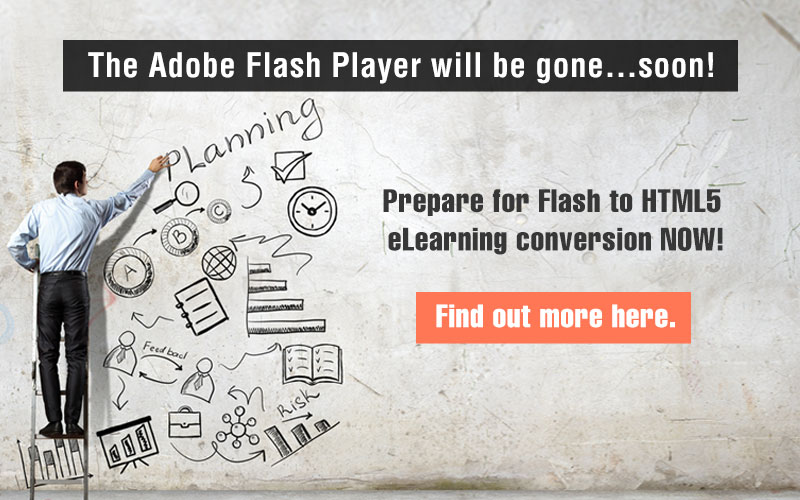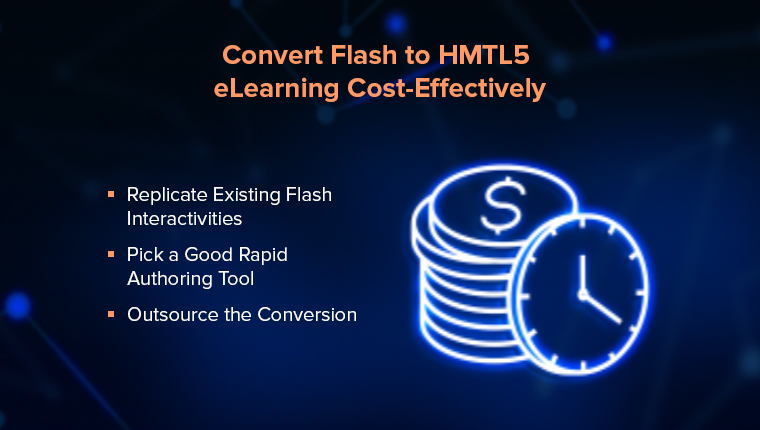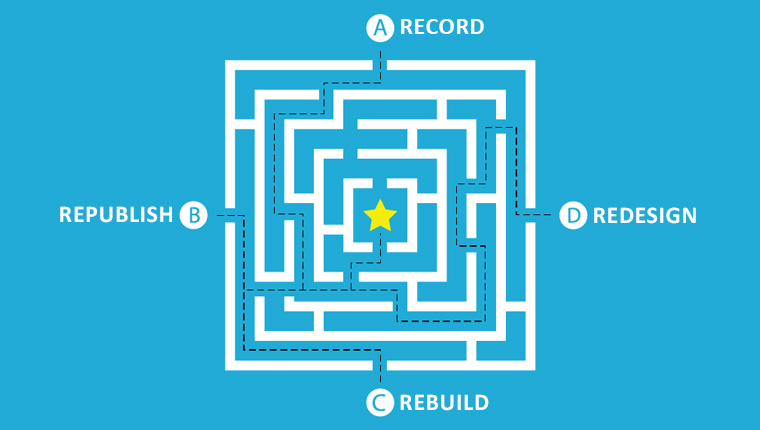Don’t Skip These 5 Steps before Flash to HTML5 Migration

The Internet is buzzing with the news of Flash’s impending demise by the end of 2020. A report by Chromium reveals that the number of Chrome users who’ve loaded at least one page containing Flash content per day has gone down from around 80% in 2014 to under 5% in 2019. What does this mean for you? Your e-learning courses developed in Flash or with Flash elements will no longer play or open in any browsers, unless you convert them from Flash to HTML5.
Flash to HTML5 Conversion: 5 Prep Steps
What do you need to decide?
- Analyze and prioritize Flash courses thoroughly
- Gather the source files
- Choose an appropriate autoring tool
- Decide on a relevant conversion strategy
- Consider adopting the latest learning strategies
Why HTML5?
HTML5 overcomes all the setback of Flash and is supported by all major technology giants such as Apple, Google, and Microsoft. It is recognized by the W3C (World Wide Web Consortium), which means your courses developed in HTML5 will be safer in the long run. HTML5 helps meet the demand for learning on-the-go and to create courses that may be accessed across devices. Thus, to cater to the new-gen workforce, and provide access to eLearning courses on all devices and screen sizes, it is necessary to migrate from Flash to HTML5.
Since Flash isn’t supported by iOS devices, it means your Flash-based eLearning is inaccessible to learners using iPhones and iPads. Therefore, consider making your courses responsive – a design approach that fluidly alters the layout of the content to fit any device (PCs, smartphones, tablets, laptops, iPhone) in which it is viewed. The course will be developed in a way that will reposition, resize, hide, or swap content for various screen sizes and resolution breakpoints.
Download this guide on responsive eLearning.
If you are among the ones wanting to transfer your legacy eLearning courses from Flash to HTML5, check out this post for a 5-point checklist on the pre-work you need to do before you begin with the conversion process.
Pre-Work Before Flash to HTML5 Conversion
1. Analyze and Prioritize Flash Courses
Begin by gathering all your eLearning resources – courses, videos, other digital resources. Then list out all the resources that require a Flash player for playing. Any file with the extension .flv or .swf needs a Flash player.
Now evaluate which of these Flash-based courses are relevant and valid for conversion. You don’t need to convert all your e-learning courses to HTML5. Let’s see how to proceed:
- Check the learning objectives of your current courses in Flash.
- Archive courses that are outdated and no longer meet the learning needs.
- Segregate relevant courses into those that:
- Can be converted to HTML5 directly
- Need updates (content, branding, or conversion to bite-sized modules)
Prioritize courses that are relevant to your learners, and plan for conversion as per their importance. If you have a course that’s accessed by a large number of employees ( compliance, code of conduct, or safety training) or a course that has high visibility (leadership training), it needs to be high on the priority list. Also, eLearning courses that are accessed frequently need to be a priority on your Flash to HTML5 migration plan, irrespective of their importance.
2. Gather the Source Files
An important part of the Flash to HTML5 conversion process is gathering the source files of Flash-based courses (.FLA and .XML) that need to be converted to HTML5. This also includes the source files of media and support files, that can be identified by their extensions .html, .xml, .css, .psd, mp4, and mp3.
Check if you have the source files of all the Flash courses you are planning to convert. Having these source files in place reduces the effort of recreating courses from scratch and eases the process of Flash to HTML5 conversion. In case you don’t have the source files, you can opt for the ‘Record’ conversion method, where existing courses are played and recorded using screencast software such as Camtasia or CamStudio. The final output is received in MP4 format which is compatible with HTML5.
This conversion strategy is best for courses without interactive elements where the learner is required to simply read each slide and listen to its narration. The main intention of the course is to help learners learn and recall facts and concepts.
3. Choose an Appropriate Authoring Tool
Selecting the right authoring tool is an important decision in the Flash to HTML5 migration process. The type of content in your existing eLearning courses is one of the factors that determines the authoring tool.
Here’s a table to help you choose the right authoring tool.
|
Purpose |
Authoring Tool |
|
Flash courses with a lot of interactivities |
Articulate Storyline 360 |
|
Flash courses with simulations |
Adobe Captivate |
|
Flash courses that are text-heavy |
Lectora Inspire |
|
Quick conversion of PPT (storyboards of Flash-based eLearning courses) to HTML5-based eLearning |
iSpring Suite |
|
Collaborative platform from Flash to responsive HTML5 |
dominKnow |
Each authoring tool has its own strengths and unique features. Analyze your content thoroughly and choose an appropriate authoring tool based on your training needs. If you need help choosing the authoring tool, you can always approach your eLearning partner to guide you.
4. Decide on a Relevant Conversion Strategy
There are 4 Flash to HTML5 conversion methodologies you can pick from.
- Record – Old courses are recorded using a screencast software and saved in the MP4 format.
- Republish – Courses are republished in newer versions of the same authoring tool.
- Rebuild – Relevant media elements are retained and the course is rebuilt with a new authoring tool.
- Redesign – The legacy course is completely revamped using a new authoring tool.
Converting your Flash-based courses to HTML5 also gives you the opportunity to:
- Update the:
- Interactivities
- Animations
- Branding
- Convert lengthy Flash-based courses to micro modules
- Repurpose content design performance solutions
Choose an effective strategy based on the status of your existing Flash course and the organizational needs.
5. Consider Adopting the Latest Learning Strategies
Now that you are have zeroed down on the conversion strategy, you might want to make legacy courses more engaging for your learners. You can consider remodeling them using modern instructional design strategies and learning techniques that engage your millennial workforce better.
You can ask your eLearning vendor about these latest eLearning trends – edutainment, empathy and personalization to name a few. Migration from Flash to HTML5 is a good opportunity to leverage these additional benefits in your eLearning program.
Parting Thoughts
So, a final word on the numerous benefits of converting your course from Flash to HTML5. The migration:
- Involves NO coding and enables eLearning professionals to convert easily using an authoring tool
- Facilitates easy customizations to the last detail
- Transforms courses with NO source files
- Eases course translations
- Offers ways to future-proof learning
- Affects the ROI positively
Converting Flash to HTML5 is definitely going to be worth it, but it should be a carefully thought out process. If you haven’t yet planned for the transition, it’s high time that you do. To get yourself ready for the transition and gain insights on planning for the conversion of your legacy courses – check our eBook Flash to HTML5 eLearning Conversion: The 4 ‘R’s That Matter.





